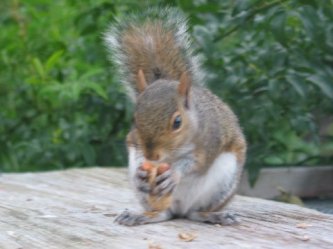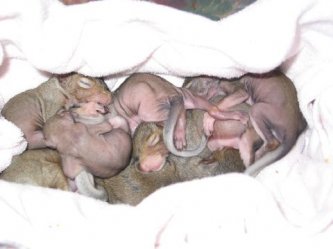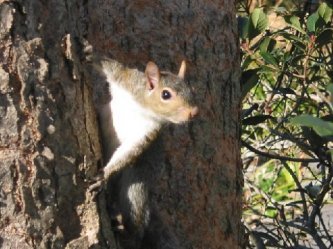Sciurus Carolineses
 Squirrels evolved between fifty- four and fifty- seven million years ago. The name “sciurus” is derived from a Greek word meaning “shade Tail”. They are a member of the rodent family of mammals. The word rodent is derived from the Latin word “rodere”, meaning “to gnaw”. During the micene era the ancestor of the squirrel evolved. Roughly 25 million years ago, squirrels diversified into tree and ground dwelling species. The specific origin of the gray squirrel is unknown. The fossilized predecestors of squirrels are classified as “paramyids”, the earliest form of rodent. This species varied in size from a few inches to beaver sized. Modern beavers are thought to be the nearest living relative to these primitive mammals.
Squirrels evolved between fifty- four and fifty- seven million years ago. The name “sciurus” is derived from a Greek word meaning “shade Tail”. They are a member of the rodent family of mammals. The word rodent is derived from the Latin word “rodere”, meaning “to gnaw”. During the micene era the ancestor of the squirrel evolved. Roughly 25 million years ago, squirrels diversified into tree and ground dwelling species. The specific origin of the gray squirrel is unknown. The fossilized predecestors of squirrels are classified as “paramyids”, the earliest form of rodent. This species varied in size from a few inches to beaver sized. Modern beavers are thought to be the nearest living relative to these primitive mammals.
Almost every activity of the modern gray squirrel involves food. Adult gray squirrels consume roughly one and a half pounds of nuts and seeds a week. Natural foods include a variety of seeds, nuts, fruit, buds, leaves, bark, and fungi. Favorite nuts include hickory, pecan, black walnut and acorns. Favorite seeds include pine, corn, black gum fruits, sugar maple, dogwood fruits, wild cherry and beechnut. Gray squirrels will eat between 30 and 60 different plants. They are omnivores. They will occasionally eat bird eggs, earthworms and beetles. They will also eat soil to obtain minerals. They will strip bark on a tree to sharpen their teeth and obtain nutrients from the sappy tissue beneath the bark. Their diet may also include mushrooms , the bones of dead animals and deer antlers. They require water at least twice a day. In winter, they will eat the snow to obtain water. Gray squirrels are scatter hoarders. They bury small amounts of food in different locations. They are capable of burying 25 nuts per hour. Experiments have shown that they use their highly developed sense of smell to locate their buried treasures. In spring, swelling buds and the flowers of the red and sugar maple are eaten. Summer food will include berries, apples, corn and other grains.
Squirrels are most active at dawn and in the late afternoon. Wind discourages movement. Squirrels are somewhat gregarious, tolerating each other in small groups when food is plentiful. Squirrels are active year round. They may stay in their den for several days during storms or severe winter weather. In winter, several immature squirrels may share the same nest.
Squirrels use two kinds of nests: tree dens and leaf nests called dreys. Leaf nests are usually summer nests. They will be built in the top fork of a tree or in the crotch of a limb neat the trunk. A single entrance usually faces the main trunk or a nearby limb. The number of active nests per squirrel is thought to be about three, depending on the density of squirrels in the area. Nest sites are periodically changed to keep parasites under control. Most squirrels are capable of constructing a nest in one day. Additional material is added from time to time. The diameter of the interior nest is usually 6 to 8 inches.
 Gray squirrels have two litters a year. The first is early spring and the second is in the fall. The litter usually consists of 3 to 5 babies. They are born pink, blind and hairless. The first hair to develop is the whiskers. Squirrels grow slowly. They are dependent on their mother for six weeks. They open their eyes around 5 weeks and have their front incisors, but will not have their grinding teeth until around the sixth week. They may continue to nurse until the 12th week. The first litter will venture from the nest around the first week of May. The second litter will become active in August. Almost as soon as young squirrels leave the nest, they begin to bury nuts. Squirrel mothers are extremely protective of their young. They do not mate for life like their cousin the beaver. Young squirrels are not automatically accepted in a territory. They must establish their position. Squirrel home ranges vary from one to seven acres. Males have a larger territory than females. They will travel in rows of trees which they have marked with scent. Squirrels are quick and nimble. They are capable of running, climbing and jumping among the branches of the highest trees. They have extremely powerful back legs and can easily jump 6 feet. They are capable of climbing almost every surface with the exception of glass. They are capable of running 19 miles per hour. They are also able to swim up to one mile.
Gray squirrels have two litters a year. The first is early spring and the second is in the fall. The litter usually consists of 3 to 5 babies. They are born pink, blind and hairless. The first hair to develop is the whiskers. Squirrels grow slowly. They are dependent on their mother for six weeks. They open their eyes around 5 weeks and have their front incisors, but will not have their grinding teeth until around the sixth week. They may continue to nurse until the 12th week. The first litter will venture from the nest around the first week of May. The second litter will become active in August. Almost as soon as young squirrels leave the nest, they begin to bury nuts. Squirrel mothers are extremely protective of their young. They do not mate for life like their cousin the beaver. Young squirrels are not automatically accepted in a territory. They must establish their position. Squirrel home ranges vary from one to seven acres. Males have a larger territory than females. They will travel in rows of trees which they have marked with scent. Squirrels are quick and nimble. They are capable of running, climbing and jumping among the branches of the highest trees. They have extremely powerful back legs and can easily jump 6 feet. They are capable of climbing almost every surface with the exception of glass. They are capable of running 19 miles per hour. They are also able to swim up to one mile.
The life expectancy of a gray squirrel is 10 years but the average life span is 18 months. An old squirrel would be 4 years old. An estimated 15 to 25 percent of young squirrels survive their first year. After the first year there is a 50 to 70 percent survival rate. About 1 percent of squirrels in a given year will survive longer than 5 years.
Natural predators include man, hawks, owls, fox, bobcats and raccoons. The greatest cause of death for squirrels is due to a combination of lack of food, secondary infection from parasites and effects of cold weather.
Squirrel language includes a vocabulary of slow warning barks, scolding, teasing and playful “clucks”. When alarmed, jerky tail movements will accompany its call. Squirrels use their calls and tail movements to warn other squirrels of danger, as well as, to intimidate their adversaries. The tail is also used for shade in the summer and a blanket in winter. The tail is used for balance when climbing and jumping.
A gray squirrel’s teeth are its most important tool. Their sharp incisors enable them to gnaw through the outside of nuts, as well as wood and plastic. The incisors will grow about 6 inches in a year and must be constantly worn down by eating or chewing.
 Squirrels have very acute senses. Their hearing enables them to be aware of any changes in their environment. They have powerful vision and a wide field of vision due to the placement of their eyes on the side of the head. It is believed they are able to distinguish color, with the exception of red and green. They are able to see fine detail in vertical objects. It is believed that a gray squirrel is able to recognize another at 50 feet away. They are able to see object movement twice as fast as the human eye.
Squirrels have very acute senses. Their hearing enables them to be aware of any changes in their environment. They have powerful vision and a wide field of vision due to the placement of their eyes on the side of the head. It is believed they are able to distinguish color, with the exception of red and green. They are able to see fine detail in vertical objects. It is believed that a gray squirrel is able to recognize another at 50 feet away. They are able to see object movement twice as fast as the human eye.
The squirrel’s fur is its first defense against the cold. It is a mixture of brown, grey and yellow on top with gray and white underneath. The range of fur color may run from gray to silver-gray to black. Extra sensitive hairs called “vibrissae” form the whiskers. The whiskers give them accurate information on the size of an opening they wish to enter. Baby squirrels are born with these facial hairs, which help them find their mother in the nest. The underneath coloring pattern of the tail can provide information on the age of a squirrel. In gray squirrels, juvenile tails have a stripe pattern to the fur. Squirrels that are 16 months and older do not have the striped variation in their tail fur.(reprinted with permission from Wild at Heart)
